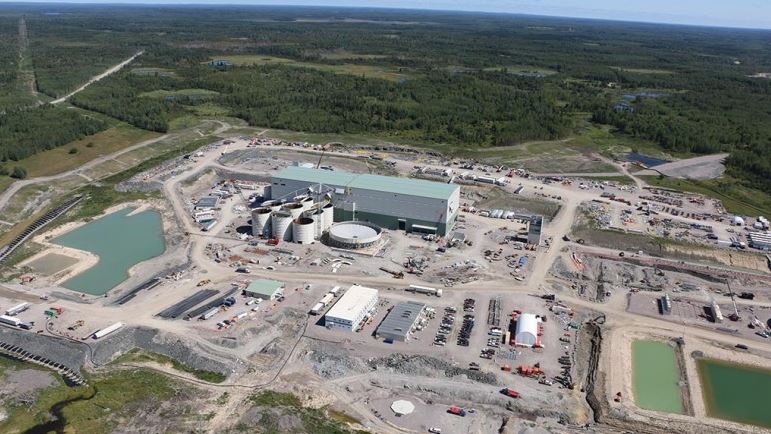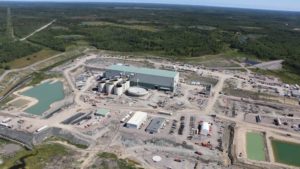Is there any way back for New Gold Inc?

The Rainy River gold mine in northwestern Ontario. Source: New Gold Inc.
By Peter Kennedy

Where is Rainy River? It’s a question that many investors were asking this week after watching the sharp decline in the share price of New Gold Inc. [NGD-TSX, NYSE American].
Since the company announced its second quarter financial results on July 25, 2018, the stock has fallen from $2.39 to a low of $1.55 on July 31, 2018, a loss of 35%.
Much of that loss has been attributed to problems at the company’s flagship Rainy River gold-silver mine near Fort France, northwestern Ontario. New Gold acquired the asset in October, 2013 by snapping up Rainy River Resources Ltd. in a deal that was valued at $310 million.
Prior to the acquisition, the property had been explored by a number of companies, including Noranda, Inco Ltd., Hudson’s Bay and Nuinsco Resources Ltd.
Rainy River is one of four mines in the company’s portfolio. The others are the New Afton Mine in British Columbia, the Mesquite Mine in the United States and the Cerro San Pedro Mine in Mexico.
In a January 16, 2018 press release, New Gold said it expected those mines to produce between 525,000 to 595,000 ounces this year, an increase of 30% on production in 2017. Of that amount, 310,000 to 350,000 ounces was expected to come from Rainy River. The company also expected to produce 75-85 million pounds of copper.
In January, the company’s all-in sustaining costs were forecast at US$860 to US$900 an ounce.
At the time, New Gold attributed the expected increase in production to a full year of operations at Rainy River, which it said would more than offset planned decreases in gold production at New Afton, Mesquite and Cerro San Pedro and the sale of the Peak Mines in Australia.
So the market was clearly caught off guard when the company revised its guidance for 2018 saying it expected to produce 415,000 to 480,000 ounces this year, including between 210,000 and 250,000 ounces from Rainy River.
Aside from the lower production, the company is estimating that all-in sustaining costs this year will come in at between US$1,080 and US$1,120, an ounce.
Rainy River is clearly the company’s primary producing asset.
Its importance to the company was recently underlined when Raymond Threlkeld was named President and CEO at New Gold. Threlkeld was President and CEO of Rainy River Resources when the company was acquired by New Gold in 2013.
In October, 2017, New Gold said Rainy River had achieved commercial production, approximately two weeks ahead of schedule, just weeks after the initial gold pour. “To date, both grade and recoveries have also been consistent with New Gold’s commissioning plan,” the company said.
However, the company has lowered its 2018 production forecasts due primarily to problems at the site. These include variability in the process facility’s start-up performance as well as lower gold grade and recoveries.
An increase in consolidated costs estimates for this year have also been attributed to Rainy River’s revised 2018 production outlook and a $15 million increase in sustaining capital estimates associated with completing the full tailings dam footprint.
Growth capital at Rainy River is also expected to increase by $15 million due to higher underground development costs, the company said.
During the second quarter of 2018, a total of 3.3 million tonnes of ore was mined and 1.5 million tonnes of ore was processed at an average gold grade of 1.24 g/t with recoveries of 87%. The company now says it is implementing a plan to increase Rainy River’s throughput to a steady 24,000 tonne per day rate.
At current levels, New Gold hasn’t been a very good investment for people who bought in when the stock was trading at over $5.
Investors looking for rebound should keep in mind that New Gold posted a loss from continuing operations of US$302 million or 52 cents per share in the second quarter of 2018. That compares to earnings of US$18 million or 3 cents in the same period last year.
The second quarter loss from continuing operations included the net impact of the after-tax impairment charge of US$282 million relating to Rainy River.
At June 30, 2018, the face value of the company’s long term debt was US$980 million. The components of the long term debt include US$500 million of 6.25% face value senior unsecured notes due in November of 2022; US$300 million of 6.375% face value senior unsecured notes due in May of 2025; and US$180 million drawn from the revolving credit facility.
The company currently has 579 million shares outstanding.
Looking ahead, New Gold said it has completed an updated Rainy River life-of-mine plan and will release an updated NI 43-101 technical report for the mine in early August. The expected mine life remains unchanged at 14 years. In the first nine years, New Gold foresees average production of 340,000 ounces annually at an all-in sustaining cost of US$1,106 an ounce.
Meanwhile, the company has been working to develop its 100%-owned Blackwater Project, located southwest of Prince George, B.C. Proven and probable reserves at the site stand at 8.2 million ounces of gold and 60.8 million ounces of silver. New Gold said activities at Blackwater continue to focus on attaining the approval of the environmental assessment (EA).
The co-ordinated Federal and Provincial EA technical review is in progress, the company said.
Technical review comments have been received from the Federal Government, provincial agencies and local Indigenous communities. New Gold says it has responded to the review comments.
The company is working through the remaining requests for information received in the quarter and anticipates approval of the Blackwater EA in 2019.

Hello. My name is Brian. I am a Serviceman for Centerra mine north west of Mackenzie BC. I was wondering what the estimated life of your Blackwater project is, or if you even have that number yet? Thank you.
17 years @ 500000+ oz. per yr. average. Brian. Potentially more is new drilling proves up more mineable oz’s.
I am a shareholder who has been to the mine site.
Sean,
Kelowna